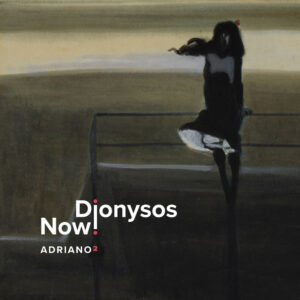Program: #23-48 Air Date: Nov 27, 2023
To listen to this show, you must first LOG IN. If you have already logged in, but you are still seeing this message, please SUBSCRIBE or UPGRADE your subscriber level today.
The recently-formed Ghent-based ensemble Dionysos Now! has taken on another in one of those remarkable projects: the complete sacred music of Adrian Willaert. Volume 2 gives is the mass on the Benedicta theme and Volume 3 is the Missa Ippolito.
NOTE: All of the music on this program comes from the Ensemble Dionysos Now! directed by Tore Tom Denys. It is on Evil Penguin label and is available as a vinyl disc at number EPRC 0043. For more information on the ensemble: www.dionysosnow.com
With this project Tore Denys wants to return to his roots in Roeselare and pay homage to one of the greatest composers in Roeselare's history.
Together with the members of his ensemble Dionysos Now!, he wants to plan a trajectory to have a contemporary reflection of his most striking signature works in 2022 — 460 years after the death of Adriaan Willaert.
For many, Adriaan Willaert is not a complete stranger, but his extensive and versatile oeuvre rarely appears in concert programmes or on CD recordings. The relative unfamiliarity with the oeuvre of the Flemish but world-renowned polyphonists is at the root of the fact that their names do not dare to be mentioned in the same breath as those of Bach, Mozart or Beethoven. Wrongly.
As a famous composer and renowned educator, Willaert gathered around him a wide circle of pupils and friends, both Italians and Flemish and Dutch, so that he can be considered the "founder of the Venetian school", an epithet that is fully justified. Willaert's oeuvre is extremely extensive: 150 motets, vespers, hymns and psalms, eight masses of chansons madrigals.
"With Dionysos Now!, I wish to show that Renaissance vocal polyphony is wonderfully captivating music that deserves to be heard by a wider audience. Dionysos Now! aims to build cathedrals out of sounds, letting you experience the music as though you were flying far above those cathedrals with a drone. The individual bricks are all there, but they seem to merge together with the whole, into the gestalt: the radiant music generates much more effervescent energy than the sum of its tones, and the music’s contagious flow is sought and captured, like a surfer who seems to have found the perfect wave and seizes his chance to ride it before it again ebbs away.
The “vehicle” that we are using to try to demonstrate this wonderful phenomenon, at least to start with, is the music of the composer Adriaen Willaert from Roeselare, Belgium.
Much of his music has remained untouched in libraries for over 450 years. But this is undeserved. In his time, Adriaen Willaert was one of the most renowned musicians in Europe. He was a singer, teacher, kapellmeister, composer, and above all a humanist. He was seen as a “master” by the many composers who studied with him who in turn became stars of their own generation. Musicians from all over Europe came to Venice to dis- cover the innovative elements of “musiklehre” with him and further hone their craft. Willaert would continue working as the kapell-meister of the San Marco Basilica for 35(!) years until his death.
Using Adriaen Willaert’s music, we delve into the spirit of that time, a turbulent period that was not so different from how the times are now, constantly changing and sometimes more confrontational than we at first can or would like to believe.
Today, Renaissance polyphony is newer than ever, and this is what we hope to show you.”
The warm reception and the positive feedback we received following the release of our debut album Adriano 1 have inspired us to dive further into the unexplored work of this Flemish master. Our fascination with Adriaen Willaert’s almost infinitely radiant oeuvre led us to this beautiful, polyphonic monument of a Mass.
The combination with the other works on this LP is no coincidence: it illustrates how the composer was acutely aware of what was going on musically in Venice, even outside the church walls of St. Mark’s Basilica. He turned folk songs, called Canzone Villanesche, into four-voice musical gems that to this day leave no one unmoved.It is striking how Willaert takes different approaches to turning spiritual texts, on the one hand, and secular songs, on the other, into gripping compositions. For example, the Mass has a polyphonic structure: one voice begins, the second voice imitates, embellishes, and passes the torch to a third, fourth, and fifth voice.
A braid of melodies arises; a wall of vocal sounds that seems to never end is erected. The text is difficult to understand, but here and there you recognize a snippet of the main melody, the Gregorian melody “Benedicta es,” on which all movements of this Missa Benedicta es are based.
It is different with the chansons: they sound polyphonic, but homorhythmic. Everyone sings the same text at the same time, so you can hear and understand the lyrics of the different verses very clearly.
Musicologists still debate to this day whether or not it was composed by Willaert. Some say that it could have come from the pen of Nicolle de Celliers de Hesdin... In any case, the fact that the mystery surrounding this music may never be solved is no reason for us not to enjoy it to the fullest in the meantime!
Side 1
- Regina Caeli Laetare
- Missa Sex Vocum Super “Benedicta" Kyrie
- Missa Sex Vocum Super “Benedicta” Gloria
- Missa Sex Vocum Super “Benedicta” Credo
Side 2
- Passa La NaveMadrigal
- Missa Sex Vocum Super “Benedicta” Sanctus
- Missa Sex Vocum Super “Benedicta” Agnus Dei
- O Dolce Vita Mia
